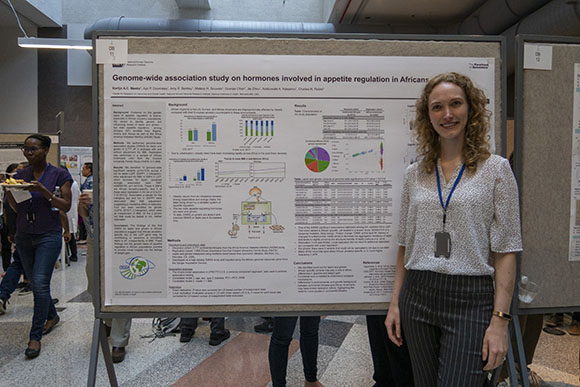2019 Research Festival: Data Blitz
A Lightning-Fast Journey into the IRP World
Punctuated by the silvery chimes of the glockenspiel, the NIH Research Festival’s first ever Data Blitz and Lightning Round launched the audience on a journey into the world of intramural research. In rapid succession, 21 postdoctoral fellows—all winners of the Fellows Award for Research Excellence—took the stage and presented three-minute summaries of their work. The glockenspiel would chime pleasantly to warn presenters when they only had 15 seconds left, but would ring noisily when time was up.
There wasn’t a dull moment as fellows enthusiastically showcased a diverse and exiting repertoire of science at NIH and described research projects ranging from the development of a wearable robotic knee exoskeleton to artificial-intelligence-powered microscopy for screening. And audience members were invited to visit the fellows’ posters after the Data Blitz to learn more about the research.
Following are highlights of a few of the presentations.
Fei Zhao (National Institute of Environmental Health Sciences, NIEHS) startled the audience into laughter when he called his research “sexy.” But he went on to give a serious talk entitled “The Remains of the Male: Unexpected Contribution of the Male Tract Mesenchyme to the Female Reproductive Tract,” in which he emphasized the critical role of the mesenchyme in sexual-organ differentiation, development, and function. Zhao’s presentation was unique because he presented very little data. When asked about this style, he admitted to approaching his mentor, Humphrey Yao (NIEHS), for advice and learned that the purpose of the talk was not to wallow in one’s data, but to capture the audience’s interest and ask questions to make them think, all in the hope of getting a big crowd to your poster.
Karlijn Meeks (National Human Genome Research Institute) summarized her research on a “Genome-wide Association Study [GWAS] on Hormones Involved in Appetite Regulation in Africans.” She talked about the importance of studying appetite-regulating hormones leptin and ghrelin to understand rising rates of obesity worldwide. Little research has been done on the genomics of these hormones in general, and none among continental Africans.
She found novel loci associated with both appetite hormones in African populations. “We found associations of variants that are only found among people with African ancestry, which really highlights the need to include diverse populations in genomics research,” Meeks said. “We couldn’t have found these results if we were only studying people of European ancestry.”

CREDIT: CHIA-CHI CHARLIE CHANG
The 21 postdocs who took part in the 3-minute lightning-round talks also invited audience members to visit their posters. Shown: Karlijn Meeks (NHGRI) whose talk and poster highlighted her research on a “Genome-wide Association Study on Hormones Involved in Appetite Regulation in Africans.”
“What happens in the first 48 hours of a viral infection?” is a question that Emily Speranza (National Institute of Allergy and Infectious Diseases) hopes to answer one day. In her lightning talk “Single-cell Analysis to Unpack the Complex Immune Responses to Early RNA Virus Infections,” she explained how she is analyzing the functional and spatial characteristics of viral infection in vivo and is identifying and differentiating infected, fighting, and immune-response-triggering cells.,
Speranza later admitted that she found it daunting, but beneficial, to condense complex research into such a short talk. It “forced me to think about what are the big goals we are trying to achieve, and what are the general methods we are using.” Her strategy for preparing for the Data Blitz included going online to observe the style of three-minute thesis-competition winners. She suggested to anyone contemplating giving a three-minute talk to “Focus on major conclusions, condense background information as much as possible, and allow just one slide for data.”
And don’t let the glockenspiel unnerve you.
This page was last updated on Wednesday, March 30, 2022
